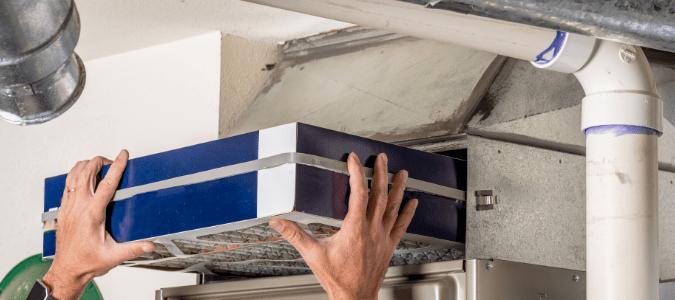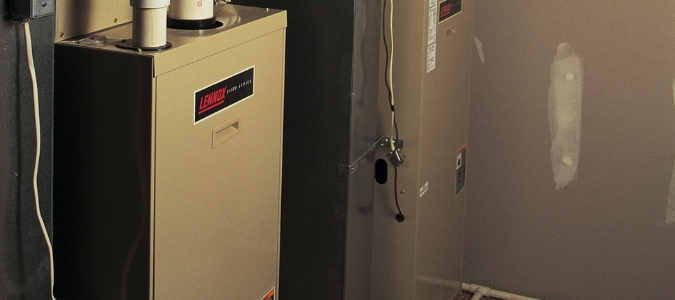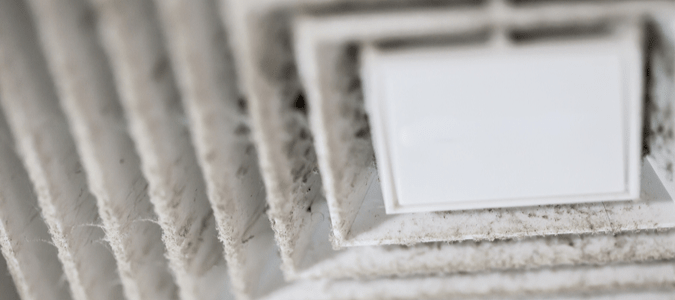
If you turn on your furnace and discover it’s not heating your home properly, you probably realize how much you take your heater for granted. In some cases, it may seem as though your furnace shuts off just about as quickly as it turns back on. If this has ever happened to you, you probably have asked yourself: Why is my furnace short cycling?
Homeowners in this situation can usually blame one (or more of the following) culprits for this issue: a clogged air filter, a dirty flame sensor, an oversized unit or a malfunctioning thermostat.
Clogged Air Filter
When your system’s filters are caked with dust particles, pet hair, pet dander and other debris that make it into your indoor environment, this buildup restricts airflow. The warm air becomes blocked in your furnace, raising its internal temperature. This warm air sends a signal to your system to shut off.
A furnace that turns off prematurely results in the temperature of your home remaining lower than your thermostat setting, which causes your furnace to turn back on again. The furnace goes through a constant cycle of being nudged to turn on because your house is not heated to the desired temperature then forced to shut off because the system is overheating. This cycle happens in short bursts which leads to short cycling. The good news is that you can remedy this situation by regularly changing out or cleaning your filter.
Dirty Flame Sensor
Your flame sensor is the component of your furnace that notifies your system when the gas valve is open and there is a flame. When this flame burns, it burns off trace amounts of water and soot. Over time, your flame sensor can become caked in this debris, making it more difficult to properly give signals to your furnace. Your furnace will think there is no flame, so it will shut off, only to turn back on again when your home is not heated to the correct temperature. Regular maintenance, ideally performed by a licensed professional, can keep this from happening, although some homeowners decide to try to attempt to clean this sensor on their own.
Furnace Is Too Big
Did you buy a new furnace this year? If so, is it bigger than your last one? You might have unknowingly gone overboard, especially if your new furnace was installed in the same area as your previous, smaller unit. If your furnace doesn’t have adequate airflow because it’s in now more cramped space, it can overheat, which then causes your heater to shut off to prevent anything bad from happening. In this scenario, your furnace will likely kick back on, because your home hasn’t reached the specified temperature. Unfortunately, if this is your problem, there is not an easy solution, and you may need to enlist the help of a licensed professional to advise you on next steps, which may involve getting a new unit.
Malfunctioning Thermostat
Another reason that your furnace might not be working correctly is that the thermostat could have some type of problem. The placement of your thermostat could be affecting the temperature of your home. If your thermostat is somewhere that gets a lot of sun or somewhere near a heat source, it may be reading an inaccurate temperature of your home, which could cause your system to regularly cycle on and off. These problems are unusual, however, and may signal a larger, more complicated problem with your heating and cooling system that may require a specialist to troubleshoot.
Now that we have covered the basics, we’ll go into more detail about air filters, flame sensors, pilot lights and a typical furnace’s lifespan so that you have the information you need to make the best decisions when faced with one of these issues.

How Often Should You Change Your Air Filter?
The most common cause of a furnace that won’t stay on for as long as it should (and a wide range of other heating and cooling system issues) is quite simple: dirty filters. Many homeowners underestimate the many problems that not changing or cleaning filters every 30 to 60 days can cause, including health issues.
If you aren’t quite sure if you’ve changed your air filter in the last two months, it’s a good idea to take a look. One rule of thumb: open up that owner’s manual before you do open up your vents. Make sure you understand your particular HVAC system setup to avoid any preventable mistakes.
In many cases, you can use a screwdriver to remove the main intake vent cover. Then, perform a simple visual inspection of how your filter looks. If it’s not its original color, or has visible build-up on it, it’s time for a change.
However, as we mentioned previously, a dirty air filter isn’t the only culprit for a short cycling furnace—a dirty flame sensor could be what’s keeping you feeling chilly inside.
Signs Your Flame Sensor Is To Blame
There are a number of tell-tale signs your sensor is the culprit, including:
- Your pilot light won’t stay lit
- There is visible soot (or rust) covering the sensor’s tip
- The tip of the sensor is completely black
Because this sensor is normally engulfed in the flame of your pilot light, it naturally collects carbon deposits, dust and other small particles that burn onto its metal parts. Additionally, all fuel-burning produces water in trace amounts. This can lead to a corrosion build-up, as well.
Even the slightest collection of deposits on this ultra-sensitive equipment can cause a failure. Fortunately, taking care of this isn’t an expensive or time-consuming fix, although most homeowners prefer to leave the job to the pros.

How To Clean A Furnace Flame Sensor
Although you can clean your furnace flame sensor yourself, it does require knowledge of how furnaces work and the proper tools., and there are serious risks involved with dealing with the electrical components of your unit. Because of these dangers, most homeowners schedule a heating tune-up well in advance of temperatures dropping so that an expert can inspect the flame sensor and many of the other parts of your furnace to ensure your system is ready for peak season.
If you decide to try to clean a dirty sensor yourself, you should know that there are essentially five steps:
- Turn off the power to your furnace.
- Remove the sensor.
- Gently rub the metal rod coming from the sensor with either very light sandpaper, steel wool or emery cloth until the soot has been rubbed off.
- Securely put it back into place.
- Turn the power back on and turn on your heater to see if your system is still short cycling. Keep in mind that because you turned off power to your furnace, it may take it a minute or two to start working again.
Prior to beginning the process, you will need to be able to identify the primary parts of your furnace and especially the parts of your flame sensor. You also need a basic understanding of how your particular model of furnace works. For instance, when turning off the power to your furnace, does it operate by a switch, or will you be flipping a breaker?
As we have already mentioned, unless you are a licensed professional, there are actually quite a number of risks to working on a furnace flame sensor yourself. If the power and/or gas isn’t successfully shut off, and the furnace kicks on while you’re working, you can suffer severe burns, and even risk a fire in your home. Any time you’re working with live electricity, you also risk electrocution.
Ultimately, to properly clean a flame sensor you can’t avoid working with both electricity and flammable gasses. Calling a heating and cooling professional to inspect and clean, or even fully replace, your flame sensor is always a safer option.
If your flame sensor has been cleaned or replaced, yet cold air is blowing out of your vents when the heat is on and your pilot light just won’t stay on, you’re probably wondering what else could be causing your heating woes.

My Pilot Light Keeps Going Out On My Gas Furnace: What’s Wrong?
If you attempted to clean your flame sensor yourself, and that didn’t seem to resolve your heating issue, you should know that there are a couple of other things that could be wrong.
A Dirty Pilot Light Orifice
Just as the flame sensor can get dirty over time, so can the pilot light orifice, which is the area where the flame rises. If you want to check this on your own, turn on your pilot light and examine the colors of the flame. The flame should be a blue color. If the flame is yellow instead, you probably need to have your pilot light orifice cleaned by a professional.
A Bad Gas Regulator
Have you been noticing problems with your gas stove as well? If so, the gas regulator that allows the flow of gas into your home may not be working properly. Because of the dangers of working with gas appliances, this problem requires the help of a professional to address.
A Bad Gas Valve
If your gas stove seems to be working fine, you could be having an issue with the gas valve, which is the component on your heater which allows the gas to flow in the unit. When it comes to gas, as we’ve already mentioned, homeowners need to be very careful. If you’re having issues with your gas line, you could have a much larger and more serious matter that a professional is best qualified to handle.
If you’ve noticed that each winter you’re needing to repair parts of your furnace, you may wonder if it’s time to start looking into a new heating system.

How Long Does a Furnace Last? Signs It’s Time For A Replacement
Most furnaces last between around 16 to 20 years. If the age of your heating and cooling system falls within that range (or beyond it), you should already be out shopping for a replacement.
So, rather than wait until an emergency occurs, or find yourself into a scenario where you’re shelling out a ton of money for repairs, consider that the most prudent path for you just may be a getting a new furnace.
Besides the actual age of the unit, there are a few telltale signs it’s time for a brand new furnace: poor performance, consistently higher heating bills, more frequent repairs, your home never quite getting to your desired temperature and strange noises coming from your unit.
Poor Performance
Ultimately, most homeowners opt to replace their furnace when they feel that their home is not warming up properly. We’ve already discussed a number of reasons this could be happening, with the most common being that filters aren’t being replaced or cleaned, which makes your unit need to work harder to move warm air through your home.
Higher Utility Bills
Although energy prices often increase over time, you may notice that your gas and electric bills are shooting up quicker than you think they should be. When your furnace isn’t running efficiently anymore, it often no longer provides the appropriate amount of heat, which can cause your monthly bill to rise. Also, as furnaces get older and parts don’t work as well as they used to, your system has to work harder to heat your home. The more energy it takes to heat your home, the more expensive your utility bills will be.
Shelling Out More For Repairs
If you’ve already spent a chunk of change on repairs in the last couple of years, you may already know the end is near for your unit. Furnaces break down the most in the last two years of their lifespan. Another sign it may be time to invest in a new unit is how difficult it was to find parts when you had to make repairs. The older your furnace is, the harder it will be to get replacement parts.
The Temperature Is Never Perfect
When you notice that some rooms are too hot while others are too cold, your furnace is probably failing to evenly distribute the air, leaving you uncomfortable in your own home. If you’re constantly adjusting the thermostat, your furnace could be on its last leg.
Strange Noises
Besides the sound of your unit coming on and off all the time due to short-cycling, other strange noises can indicate a problem as well. A noisy furnace can mean your furnace is reaching the end of its life. Common sounds include popping, banging, rattling and even squeaking.
When it comes to your family’s safety and comfort, the benefits of having a brand new furnace are often worth the investment. If you see some of these signs, but still aren’t quite sure whether now is the time to replace it, contact a reliable heating and cooling company for an inspection.
ABC Can Handle Your Furnace Issues
Furnaces are often located in difficult to reach areas, and working on them requires a thorough understanding of how these systems work. Instead of risking damage to your system, or even worse, yourself, call in the professionals at ABC Home & Commercial Services. We are fully equipped to work on every make and model of furnace and even offer 24/7 services. With ABC’s help, you won’t have to worry about becoming an expert, because we can keep your heating and cooling systems working well, all year long.
